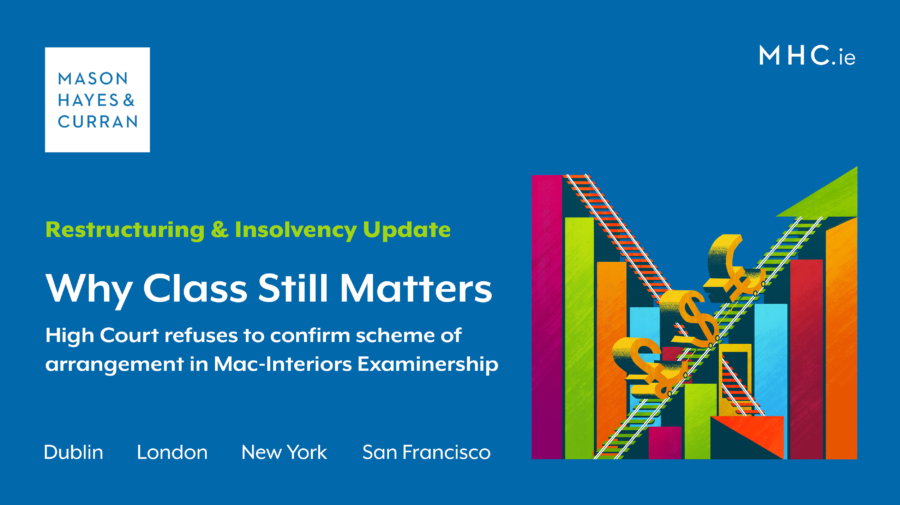
The recent High Court decision in Mac-Interiors Limited has clarified the law regarding class composition in examinerships in Ireland. Our Restructuring & Insolvency team reviews the decision and the practical implications for the law in this area.
The High Court has refused to confirm proposals for a scheme of arrangement (the “Proposals”) formulated by the examiner of Mac-Interiors Limited (the “Company”), based on an objection as to the validity of the division of the creditors into classes.
Background
An examiner was appointed to the Company in May 2023, and the required meetings of members and creditors were summoned to consider and vote on the Proposals in late August 2023.
The examiner must divide the creditors into classes to vote on proposals for a scheme.
The Proposals provided for the creditors to be divided into the following classes, with the dividends indicated to be paid to the members of each class:
(a) Senior Secured Creditor: 100%
(b) Preferential Creditors: 100%
(c) Retained Project Creditors: 1.5%
(d) Unsecured Creditors: 1.5%[1]
(e) Contingent Guarantee Creditors: 1.5%
(f) Guaranteed Creditors – dividend: 1.5%
(g) Contingent Litigation Creditors – dividend: 1.5%.
Classes (c) to (g) are all unsecured creditors. It was estimated that in liquidation, if the Proposals were not approved, they would all fare worse and receive a dividend of 0.133 %.
It appears to have been accepted by all parties that the criteria for the approval of the Proposals were met except for a challenge by the Revenue Commissioners (“Revenue”) as to how the classes of creditors were made up and, in particular, the existence of the Retained Project Creditor class.
At the meetings convened by the examiner, Revenue - noted in the Proposals as having preferential debt of just over €1 million and non-preferential debt of €13.2 million - voted against the Proposals. Just one class of impaired creditors, the “Retained Project Creditors”, voted in favour of the Proposals.
Revenue’s objection to the Proposals
Revenue objected to the Proposals at the confirmation hearing on the grounds that the class of “Retained Project Creditors” was improperly formed and that this was a material irregularity at or relating to a statutory meeting of the creditors.
Revenue submitted that the appropriate principles to apply to class formation in examinerships are the same as for schemes of arrangement under Part 9 of the Companies Act 2014 (the "Act")[2]. Key amongst those principles is that all creditors with similar legal rights should be in one class, unless there is a clear explanation in the Proposals for a scheme of arrangement as to the rationale for the distinction.
The class of the Retained Project Creditors comprised creditors whose claims arose from or were associated with projects of the Company that were ongoing. Accordingly, the examiner submitted the members of this class were likely to have a continuing trade relationship with the Company. On that basis the examiner submitted there was a good reason to treat them as a separate class. In addition, the examiner submitted that it was not at all uncommon for examinership schemes to segregate categories of unsecured creditors into separate classes not always based on different legal rights.[3]
The examiner also submitted that while the so-called “rights based” approach is the correct starting point for the analysis, this is too rigid and must be modified for examinership.
The Court was therefore required to determine two issues:
- Is the composition of classes for an examiner’s scheme of arrangement governed by the same principles which govern class composition in schemes of arrangement outside examinership under Part 9 of the Act?
- Was the formation in this case of the class of Retained Project Creditors valid having regard to the applicable principles for class composition?
“Rights” versus “interests” test in class formation
On the first issue, the Court ultimately agreed with Revenue’s submission that the correct approach to the classification of creditors in examinership is the “rights-based approach” set out in old English case law.
The Court concluded, however, that while the relevant test is correctly described as a rights-based one,
“…even where rights differ, there may be sufficiently common interests, or “more that unites than divides”, such that creditors who would otherwise be divided by the rights based test can be required to consult together. That is the relevance of “interests”.
It further held however, that the test “…is not a basis for building a class based only on a “common interest”".[4]
Importantly, the Court further observed that “caution should be exercised where the formulation of a class may have the effect of rendering eligible for confirmation a scheme, rejected by all other impaired classes, which would not otherwise have been so eligible”
On the second issue, the Court determined that there was an insufficient distinction between the rights and interests of the class of “Retained Project Creditors” and the unsecured class of creditors to justify the subdivision of those classes under the Proposals. The Court held that:
“it can only be in exceptional circumstances that different non-rights based interests can be invoked to subdivide a class whose rights are identical.”
Notably, the Court held that all other requirements had been met by the Proposals, including that the ‘best interests of creditors’ test was satisfied.
Following the decision, the examiner sought further time to seek new investment and present revised proposals for a scheme of arrangement. However, the Company was placed into liquidation by order of the Court on 11 October 2023.
Comment
This decision has important implications for how classes of creditors are formed in examinerships. It confirms that the test to be applied by examiners in creating classes of creditors is essentially the same as is applied to schemes of arrangement under Part 9 of the Act. The Court will therefore adopt a primarily “rights based” analysis and will essentially look to whether there is “more that unites creditors than divides them”.
One possible consequence of this judgment may be a rise in applications for direction by examiners seeking court approval of the construction of classes of creditors before putting the Proposals to the creditors.
We note that the judgment does not directly address the question of whether a Court will find it permissible for non-preferential Revenue debt to be placed in a distinct class from the general unsecured creditors. The Court observed in passing that the rights of the Retained Project Creditors and the unsecured creditors were “more coincidental” than those of Revenue (in relation to is non-preferential debt) and the unsecured creditor class. Therefore, the question remains somewhat open.
For more information on the implications of this decision, contact a member of our Restructuring & Insolvency team.
The content of this article is provided for information purposes only and does not constitute legal or other advice.
[1] The original proposals had 8 classes including Revenue as a non-preferential creditor.
[2]As developed in the line of authorities following the judgment of Bowen L.J. in Sovereign Life Assurance Company v. Dodd [1892] 2 QB.
[3] A report was exhibited by the examiner which reviewed every publicly available examinership scheme or court order of the last 6 years and concluded that every such scheme had more than a single class of unsecured creditors that would otherwise rank pari passu in a liquidation of the relevant company – see para 71 of the judgment (In the Matter of Mac-Interiors Limited, High Court, Quinn J, 9 October 2023, [2023] IEHC 549)
[4]
See paragraph 112 of the judgment.









